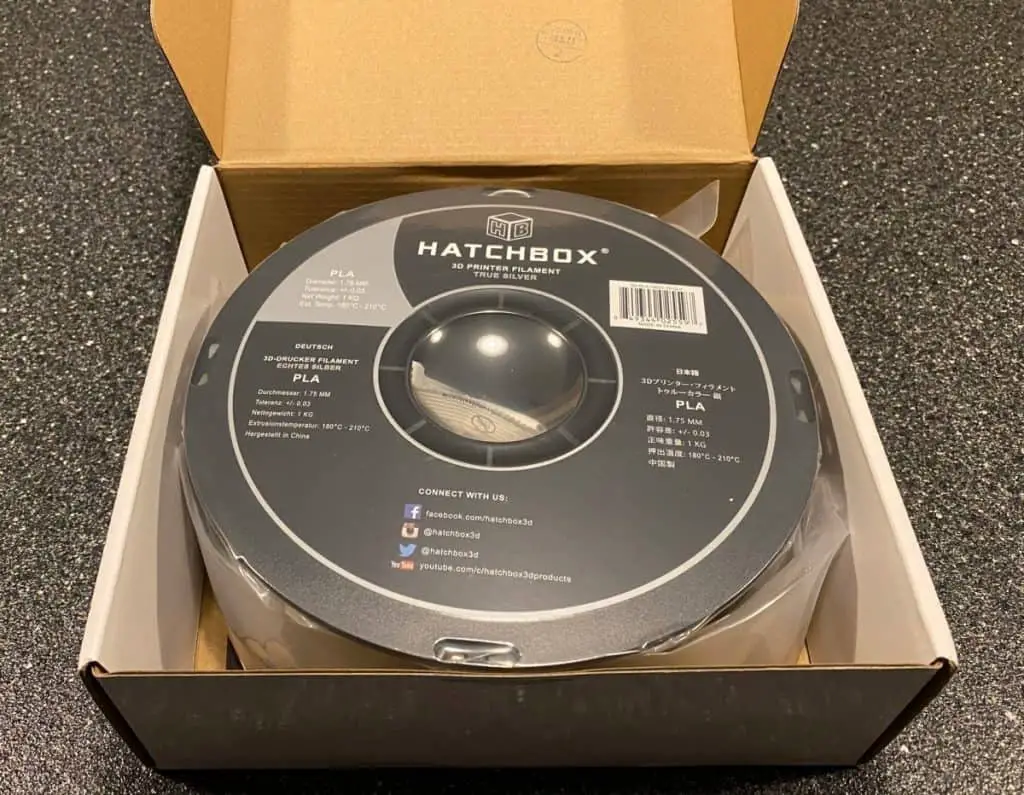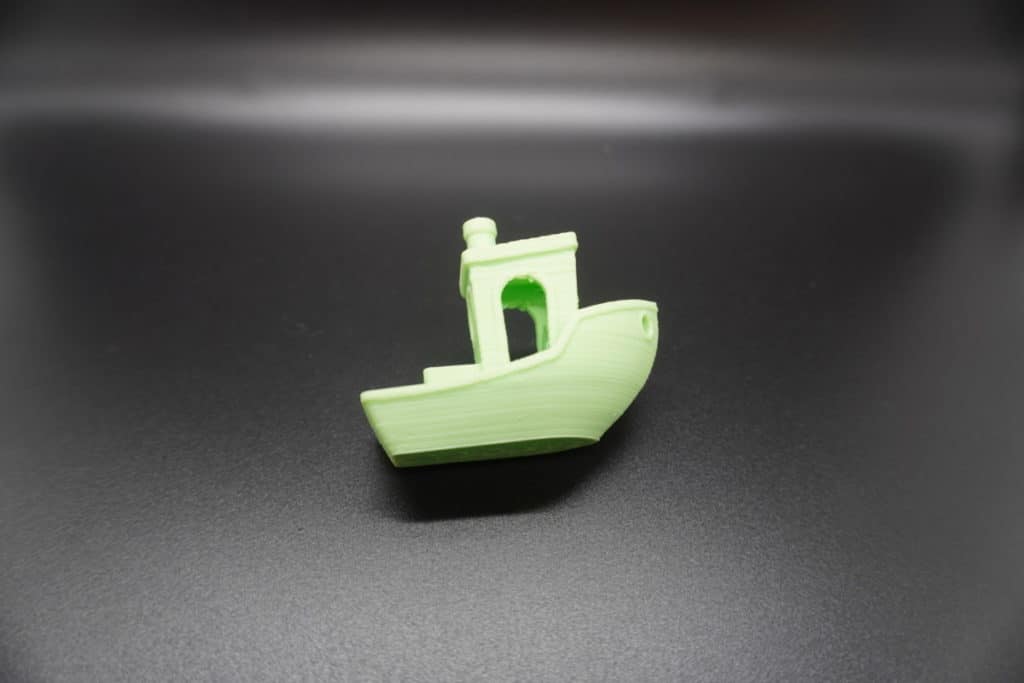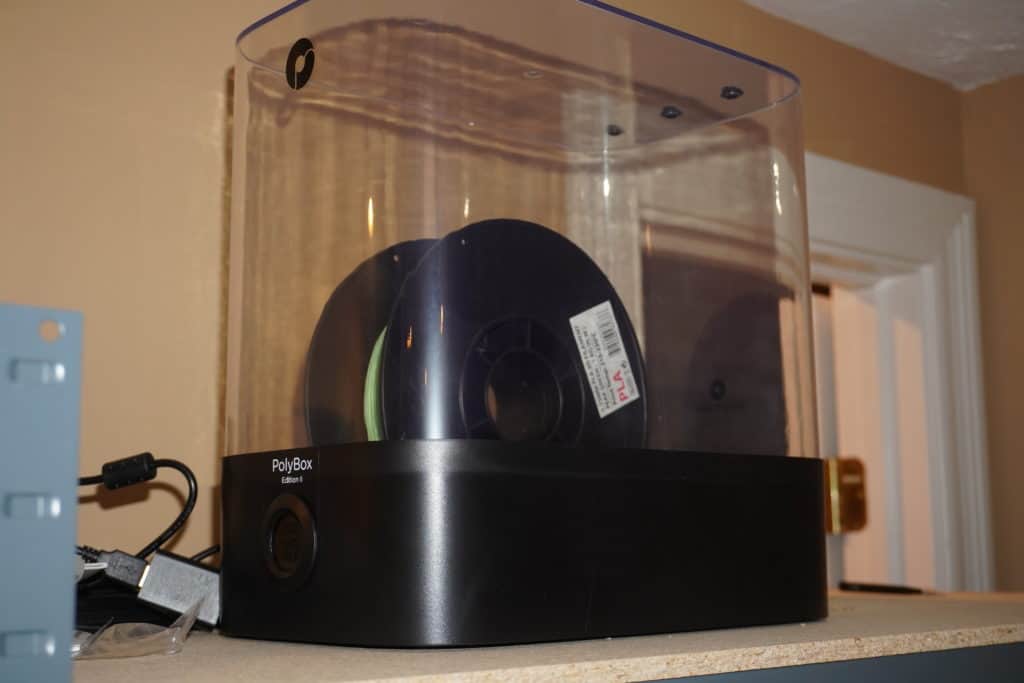PLA remains one of the most popular materials used for 3D printing because it’s easy to work with and cheap. What most people tend to overlook is how to store the filament properly when not in use.
Does PLA need to be kept dry? Standard PLA will absorb moisture and won’t print as well when wet. Known as a hygroscopic, PLA absorbs moisture from its environment, so you want to keep your filaments in a dry location when in storage for the optimal printing experience. You might plug in a dehumidifier to keep it dry.
Keep reading to learn more about how to keep your PLA filament dry for the best 3D printing results.

Why Water Causes Printing Problems with PLA
Water in a PLA filament often bubbles as it extrudes from the nozzle because it interferes with the 3D printer and the filament. PLA will have a rougher texture, and more imperfections like blobs, stringing, and a bubbly texture because of the added water. Think of a Coke and how water can quickly ruin the flavor. The same happens with PLA and water.
Especially in a more humid environment, PLA should be well covered and protected to prevent printer problems. Dryer environments don’t harm the filament because it doesn’t absorb the moisture.
How to Tell When a PLA Filament Absorbed Moisture
First, check for blobs, stringing, or rough textures on the filament. You may see uneven extrusion lines or a brittle and less flexible filament. Many times, the filament breaks more easily when wet. If heated in the 3D printer, you may hear crackling sounds. The crackling happens because of bubbles that form and escape in steam.
Watching for bubbles or hissing sounds from the 3D printer will give you an advance warning on if the filament has water. This goes for all filaments that may absorb water.

How to Eliminate Water from a Wet Filament
Perhaps the simplest way to dry a filament of water is to put it in the oven. You want to set the temperature to below the glass transition of the filament. Most recommend that you leave the filament in the oven for four to six hours to ensure that you dry it out.
PLA melts at around 160 to 180 degrees Celsius. Before you put the PLA in the oven, wait until it preheats. Most ovens will overshoot the temperature during the preheat and bring it down to the correct temperature. If you don’t do that, you will soften the plastic and fuse parts of the filament together.
I wouldn’t advise that you do it with an oven, but if you don’t have other options, this can eliminate the moisture. Convection ovens work particularly well because of how it circulates the air around in the oven. Just watch it closely when doing this. Also, don’t do this with propane or natural gas-fired ovens since this type of heat produces water vapor, which was what caused the problem to begin with.
The second option, probably a superior choice to putting in the oven because of the lower temperature, is putting your filament into a food dehydrator. It operates at a lower temperature and doesn’t carry as much risk. One of the advantages of this is that with the right one, you can dry out two at the same time.
You could also use something that has become known as a filament dryer. A filament dryer gives you the ideal way to dry your filaments. Manufacturers designed them to remove moisture from the filament, and most modern 3D printers will include a filament dryer as part of the package since the problem has become so common with PLA and other filaments. Many times, the filament dryer will work right alongside the 3D printer to save you on the hassle.
Like with the other methods, a filament dryer works by heating the air and cooking away the moisture. Even if you had to buy it, a filament dryer offers you an affordable solution to keeping your filaments free from moisture.
What to Look for in a Filament Dryer?
The perfect filament dryer will ensure the least interruption during the 3D printing process. For example, a good dryer can dry your filament and print at the same time. In addition, the dryer will also be compatible with most filaments on the market. PLA is only one of many that are sensitive to moisture in the air.
Look for a filament dryer that operates quietly and won’t disturb the environment. Some will come with an LCD monitor to watch the temperature and time.
Best Storage Practices for Your PLA Filaments
For the best filament practices, you will need a few supplies that we will include below:
- 1-gallon plastic storage bags
- Duct tape
- Permanent marker
- Bag of 20 to 30 silica gel desiccant packs
You can use the silica packs multiple times if you dry them out in the oven. The plastic bags also tend to be a one-time investment. An optional storage point but not necessary, you could buy a humidity-controlled cabinet to keep the area free of humidity.
Next, you will put the filaments in the bag and date and wrap them. We say to put a date on the bag because of how filament won’t last longer than a year. This action ensures that you can finish the filament before it expires. In the next step, you will cut two 3-inch pieces of duct tape and stick one on each side of the bag. That matters because the bag will start to split over time. Doing this will reinforce the bag to last longer.
You may also choose to buy vacuum-sealed bags, which keep the moisture out of the bag. The vacuum seal will keep the dust away from the filaments, which can also interfere with the printing.
Next, add two silica gel packs into the bag with the filament and seal it. Before you seal the bag, remove as much air from the bag as possible. Finally, store it in the area that you designated for the filaments. You want this to be a cool and out-of-the-way area where it won’t be exposed to humidity.

What Filaments Absorb Moisture?
Besides PLA absorbing moisture, you should be aware of some other filaments prone to absorbing moisture as well. Copolyester, nylon, nylon blends, acrylic and polycarbonate all absorb moisture. To give you an idea of how quickly it can happen, all of these filaments can absorb enough water to ruin your 3D print in as little as 48 hours.
Dry Before Printing
Many 3D printer enthusiasts skip the process of checking to see if it dried well enough and dry it right from the get-go. It eliminates the trouble that you may encounter from having a filament full of too much moisture. To prevent problems, all filaments, whether PLA or ABS, should be stored away to keep moisture from them.
Why is Moisture such a Problem for 3D Printers?
After an estimated six days exposed to moisture, your PLA filament can swell by as much as 40 micrometers. Because 3D printers require tight tolerances and extremely small layer heights, it can stop the printer from printing before it even gets started. An estimated 20 to 40 microns, roughly the size of a human hair, can derail your efforts at 3D printing.

Don’t Over-Dry the Filaments
Drying the filament for a longer time will make it easier to 3D print filaments, but you should exercise caution. Don’t dry it too much because you don’t want the plastic to burn up because of overheating or render it unusable.
Why Does PLA Absorb Moisture?
Like all other filaments and how well it absorbs moisture, it depends on the chemical structure of the resin. PLA, a thermal plastic monomer, has double bonds, which gives the water many points to attach to through hydrogen bonding. Because of that, the moisture bonds with the plastic and makes it hard to remove. PLA isn’t as hygroscopic as other filament choices like ABS or Nylon, but it still absorbs moisture. In fact, most consider PLA one of the least moisture absorbing, but you still need to take precautions.
Excess moisture won’t just hurt the filament when you go to 3D print it, it will also shorten the lifespan of filaments.
Related Articles
- Can You Spray Paint PLA? Details Inside!
- Best PLA Glue – The Answer Inside!
- What Is The Best Primer For 3d Prints?
- All About 3D Printer Plastic
- Can You Drill Into and Cut 3D Printed Plastic?
Conclusion
All filaments, including PLA, should be stored in a humidity-controlled area to prevent it from absorbing moisture. You will see better-quality prints with extra effort. Don’t worry too much if your PLA filament absorbed some water, however, because you can usually dry them out with one of the methods outlined. PLA does reasonably well, but like your other filaments, it can’t hurt it to keep it stored in a decent location away from moisture. While a dry box may not be totally necessary with PLA, any filament exposed to humid conditions leaves the door open for problems.
Make sure you check out our YouTube channel, and if you would like any additional details or have any questions, please leave a comment below or join us on Discord. If you liked this article and want to read others click here.
